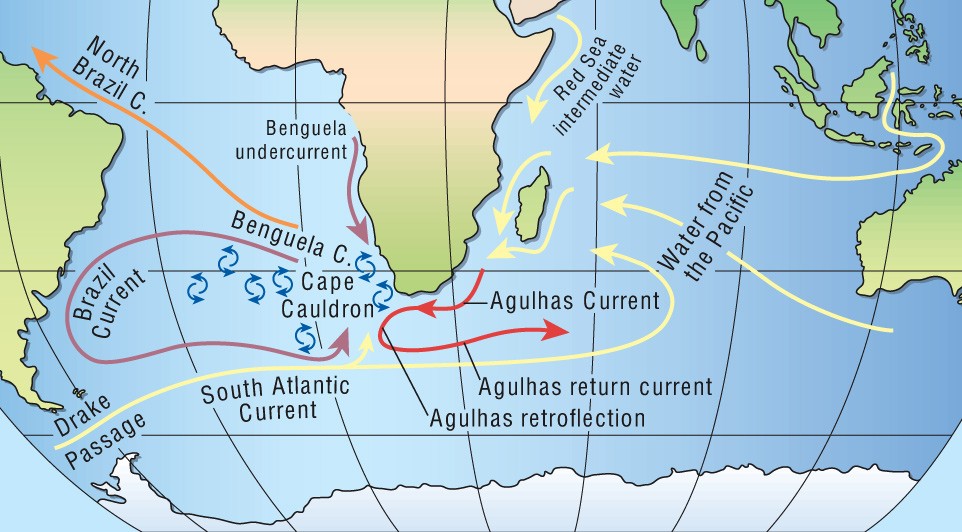Uncovering the Stories of Southern Africa’s Climate Past
Sidney Hemming is preparing to spend two months at sea studying global ocean circulation and southern Africa’s climate variability over the past 5 million years.

I am on my way to Mauritius to spend a few days with my husband, Gary, before boarding the JOIDES Resolution in Port Louis for a two-month research cruise, IODP Expedition 361, South African Climates. This is my first cruise as co-chief scientist, so I am both excited and nervous. The goal of the cruise is to obtain climate records for the past 5 million years at six sites around southern Africa. Each has its own special focus.
As with research cruises in general, this represents the culmination of a huge effort over many years, in this case led by Rainer Zahn and my co-chief scientist, Ian Hall. Those efforts included planning workshops, site survey cruises, proposal writing and re-writing, and a lot of development of stratigraphic records and proxies of climate-sensitive factors such as temperature and salinity of surface and intermediate waters, positions of the “Agulhas Retroflection,” and evidence for deep ocean circulation.
The cruise is going to an exciting place in the global climate system. Evidence for the vigor of North Atlantic Deep Water overturning circulation (a.k.a. the Great Ocean Conveyor) can be found in the same sediment cores taken from the floor of the southern Cape Basin, off the southwest coast of South Africa, where scientists have found evidence for Agulhas “leakage” of warm, salty water from the Indian Ocean into the Atlantic Ocean.
The Agulhas Current is the strongest western boundary current in the world’s oceans. It flows along the eastern side of southern Africa, and when it reaches the tip of Africa, it is “retroflected” to flow east, parallel to the Antarctic Circumpolar Current. Changes in the Agulhas Current are coincident with climate change in Africa, and thus it may even have been an important factor in the evolution of our species in Africa. Lamont-Doherty Earth Observatory’s Arnold Gordon has made the case that leakage of salt and heat from the Agulhas Current into the Atlantic Ocean is one of the ingredients that enhances North Atlantic Deep Water overturning circulation.
On this cruise, we’re studying the current to collectively try to uncover the story of southern African climates and their connections with global ocean circulation and climate variability for the past 5 million years.
My role is to use the layers of sediment on the ocean floor that either blew in or washed in from land to contribute to understanding of rainfall and runoff, weathering on Africa, and changes in the Agulhas. (I’m working on this in collaboration with fellow sailing scientists Allison Franzese of Lamont, Margit Simon of the University of Bergen, and Ian Hall of Cardiff University, and shore-based scientist Steve Goldstein at Lamont). Questions about rainfall and runoff and weathering will be tackled in sediment cores that are near major rivers. These efforts will also serve to characterize the composition of sediments being carried in the Agulhas Current.
Fortuitously, the sources of sediments along the eastern coast of South Africa have significantly different radiogenic isotopes than those on the western side. Radiogenic isotopes are isotope systems that change due to radioactive decay of a parent isotope and thus respond to the time-aspects of geologic history. We discovered during the Ph.D. thesis of former graduate student Randye Rutberg that in RC11-83, a pretty famous sediment core from the southern Cape Basin, the land-derived sediments have a higher ratio of Strontium-87 to Strontium-86 during warmer climate intervals than during colder intervals, and the values are so high as to require an external source—that is the eastern side of Africa and carried into the Atlantic via the Agulhas leakage.
Franzese did her Ph.D. thesis on land-derived sediment evidence of changes in the Agulhas between glacial times, about 20,000 years ago, and modern times. She documented the map pattern of variability of both the sources and sediment changes, and further confirmed the role of the Agulhas Current in depositing sediments in the South Atlantic. It will be super exciting to extend the observations back to 5 million years and explore how the sources, as well as the Agulhas Current itself, may have changed.
Sidney Hemming is a geochemist and professor of Earth and Environmental Sciences at Lamont-Doherty Earth Observatory. She uses the records in sediments and sedimentary rocks to document aspects of Earth’s history.
